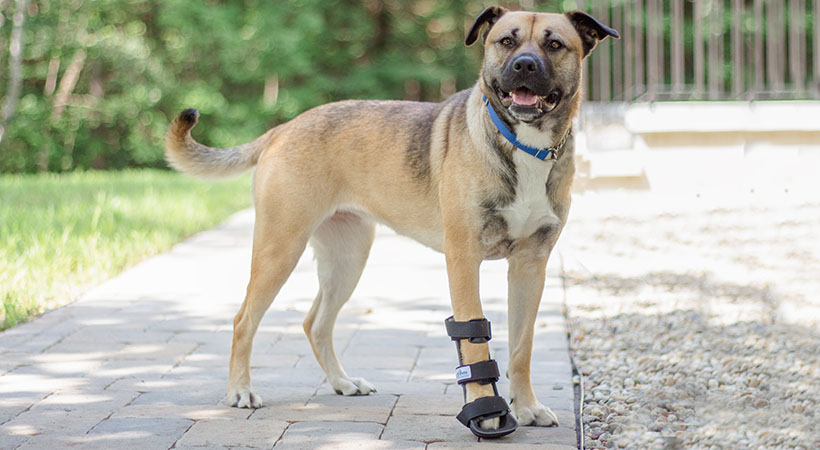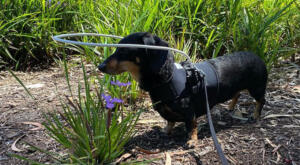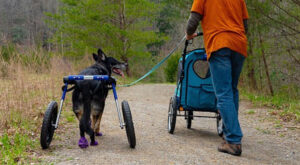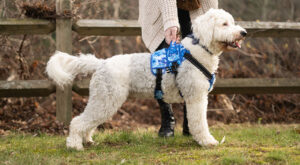The Splint Placement Needs to Be Correct
For your pet’s safety and treatment plan, only a veterinarian should brace a pet’s injured leg. Always work with your veterinarian to ensure your dog’s splint is placed correctly. An improperly fitted or placed splint can cause skin irritation, swelling, and injury. Your veterinarian will help select the right leg splint to make sure the splint is supporting the injured portion of your dog’s leg. The correct splint should support above and below the injured joint or ligament.
How to tell that a dog’s splint fits correctly:
- All toes and paw fit comfortably in the paw portion of the splint.
- Straps are snug but not too tight.
- The pet’s leg fits comfortably into the splint.
- The bend in the splint perfectly aligns with your dog’s natural leg shape.
The Fit Should Be Snug, But Not Tight
A splint should fit your dog snugly but should not be too tight or uncomfortable. Look for signs that your pet’s splint is too small. Are the toes hanging out over the edge of the splint? Is your pet’s skin bulging over the straps or sides of the splint? A too-small splint can be uncomfortable and may cause additional injury.
Signs the splint is too small:
- The paw portion of the splint is not long or wide enough.
- The dog’s fur or skin is bulging over the strap or sides.
- The bend in the splint sits below the carpal or hock joint.
- The leg will not fit fully into the splint.
The Splint Should Not Be Too Loose
Your pet’s splint should fit comfortably. If a dog splint is too loose, it could cause the splint to shift or move unexpectedly. Once the splint is on your dog, look for signs of gapping, or spaces where the splint is not touching your dog’s leg – this could mean the splint is too big and not offering enough support to the limb.
Signs the splint is too big:
- Splint length goes too high up on the leg.
- The bend in the splint sits above the carpal or hock joint.
- The splint shifts or moves on its own.
- The paw portion of the splint is too wide.
- The pet can easily remove the splint.
Always Check to Avoid Overtightening
An overly tight splint can lead to swelling, place unnecessary pressure on the limb, and be painful. After positioning the splint, look at your dog’s toes, paw, and leg. Are there any signs of swelling, irritation, or change in color? If so, your dog’s splint is too tight or doesn’t fit properly. Contact your veterinarian if your dog’s limb is swollen, cold to touch, or any other change in appearance after applying a splint.
To avoid accidentally overtightening your pet’s splint straps, never tighten from the top down or bottom up. This can sometimes cause you to gradually tighten as you work your way down or up. Instead, tighten the bottom strap first, then adjust the top strap before moving on to the middle straps. Afterward, check each strap. If adjusted correctly, you should be able to slide a finger comfortably under each strap.
Splint Best Practices:
- Keep the splint dry and clean.
- Limit your dog’s exercise, avoid jumping while wearing the splint.
- Leash your dog when going outside to limit activity.
- Regularly check your pet’s leg for skin irritation or signs of rubbing.
- Have the splint placed by a veterinary professional.
Before trying a splint, your veterinarian should assess your dog’s injury to determine whether a splint is the right treatment option for your pet.
When Introducing a Splint to Your Pet:
Be sure to always start slowly when introducing new products to your pet. Monitor your pet for signs of rubs or tightness and remove the splint if these become present. We recommend having your pet wear the splint for 5-10 minutes at a time until you are certain the fit is appropriate, and your pet is comfortable wearing the splint.
If there are any areas of concern, please reach out to our Customer Care Team or refer to your regular Veterinarian, as a different size may be more appropriate.
Related Articles:







